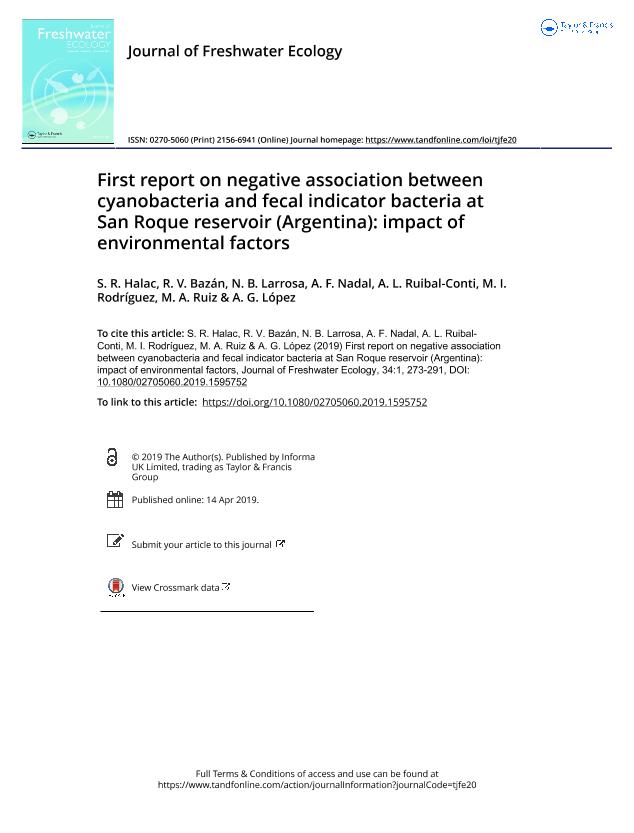Mostrar el registro sencillo del ítem
dc.contributor.author
Halac, Silvana Raquel

dc.contributor.author
Bazán, Raquel del Valle

dc.contributor.author
Larrosa, Nancy Beatriz

dc.contributor.author
Nadal, Ana Florencia

dc.contributor.author
Ruibal Conti, Ana Laura

dc.contributor.author
Rodriguez, Maria Ines
dc.contributor.author
Ruiz, Marcia Andrea

dc.contributor.author
López, Abel Gerardo

dc.date.available
2021-02-12T18:19:23Z
dc.date.issued
2019-01
dc.identifier.citation
Halac, Silvana Raquel; Bazán, Raquel del Valle; Larrosa, Nancy Beatriz; Nadal, Ana Florencia; Ruibal Conti, Ana Laura; et al.; First report on negative association between cyanobacteria and fecal indicator bacteria at San Roque reservoir (Argentina): impact of environmental factors; Oikos Publ Inc; Journal Of Freshwater Ecology; 34; 1; 1-2019; 273-291
dc.identifier.issn
0270-5060
dc.identifier.uri
http://hdl.handle.net/11336/125616
dc.description.abstract
The aim of this study was to evaluate the co-occurrence of some frequent fecal indicator bacteria and cyanobacteria species at San Roque reservoir (SRr), highlighting the relationship between their variability and environmental factors. This study was carried out at SRr (31°22′ S, 64°27′ O) located west of the city of Cordoba, Argentina. Physico-chemical measurements and sampling for microbiological and nutrient determinations were done at three recreational sites, during seasons of major touristic activity (spring-summer), with the aim of identifying temporal patterns of microorganism variability. In addition, we carried out laboratory experiments with local isolated bacteria (Escherichia coli and Enterococcus spp.) and axenic Microcystis aeruginosa cultures to assess an association among these microorganisms and evaluate whether it was positive or negative. Our results showed an inverse relationship between cyanobacteria and thermotolerant coliform bacteria (TtC) at SRr, which was only observed when high cyanobacteria concentration occurred (≥3.4 × 104 to 1.2 × 106 cell.mL−1). Experimental results also showed this type of relationship: E. coli and Enterococcus spp. decreased their growth in the presence of M. aeruginosa. In addition, it was observed that the variability of main phytoplanktonic species and TtC at SRr was mainly explained by temporal patterns, that is, the seasonal changes and the hydrological year. In summary, our data indicated that cyanobacteria high abundance during bloom periods could be an inhibiting factor for bacteria growth at SRr. Moreover, we demonstrated that nutrients such us P and N are not the main factors determining the variability of studied microorganisms in this eutrophic reservoir, but other factors, such as climatic conditions (temperature and precipitations), have a major influence. This study would provide a more comprehensive view on the dynamics of microorganism populations with sanitary relevance in eutrophic reservoirs.
dc.format
application/pdf
dc.language.iso
eng
dc.publisher
Oikos Publ Inc

dc.rights
info:eu-repo/semantics/openAccess
dc.rights.uri
https://creativecommons.org/licenses/by-nc-sa/2.5/ar/
dc.subject
CYANOBACTERIA BLOOM
dc.subject
ESCHERICHIA COLI
dc.subject
EUTROPHIC RESERVOIR
dc.subject
HYDROCLIMATIC VARIABILITY
dc.subject
MICROCYSTIS AERUGINOSA
dc.subject
THERMOTOLERANT COLIFORM BACTERIA
dc.subject.classification
Oceanografía, Hidrología, Recursos Hídricos

dc.subject.classification
Ciencias de la Tierra y relacionadas con el Medio Ambiente

dc.subject.classification
CIENCIAS NATURALES Y EXACTAS

dc.title
First report on negative association between cyanobacteria and fecal indicator bacteria at San Roque reservoir (Argentina): impact of environmental factors
dc.type
info:eu-repo/semantics/article
dc.type
info:ar-repo/semantics/artículo
dc.type
info:eu-repo/semantics/publishedVersion
dc.date.updated
2020-11-25T16:14:03Z
dc.journal.volume
34
dc.journal.number
1
dc.journal.pagination
273-291
dc.journal.pais
Estados Unidos

dc.journal.ciudad
Londres
dc.description.fil
Fil: Halac, Silvana Raquel. Consejo Nacional de Investigaciones Científicas y Técnicas. Centro Científico Tecnológico Conicet - Córdoba. Centro de Investigaciones en Ciencias de la Tierra. Universidad Nacional de Córdoba. Facultad de Ciencias Exactas Físicas y Naturales. Centro de Investigaciones en Ciencias de la Tierra; Argentina. Instituto Nacional del Agua. Gerencia de Programas y Proyectos. Centro de la Region Semiarida.; Argentina
dc.description.fil
Fil: Bazán, Raquel del Valle. Universidad Nacional de Córdoba. Facultad de Ciencias Exactas, Físicas y Naturales; Argentina
dc.description.fil
Fil: Larrosa, Nancy Beatriz. Universidad Nacional de Córdoba. Facultad de Ciencias Exactas, Físicas y Naturales; Argentina
dc.description.fil
Fil: Nadal, Ana Florencia. Universidad Nacional de Córdoba. Facultad de Ciencias Exactas, Físicas y Naturales; Argentina
dc.description.fil
Fil: Ruibal Conti, Ana Laura. Instituto Nacional del Agua. Gerencia de Programas y Proyectos. Centro de la Region Semiarida.; Argentina
dc.description.fil
Fil: Rodriguez, Maria Ines. Instituto Nacional del Agua. Gerencia de Programas y Proyectos. Centro de la Region Semiarida.; Argentina
dc.description.fil
Fil: Ruiz, Marcia Andrea. Instituto Nacional del Agua. Gerencia de Programas y Proyectos. Centro de la Region Semiarida.; Argentina
dc.description.fil
Fil: López, Abel Gerardo. Universidad Nacional de Córdoba. Facultad de Ciencias Exactas, Físicas y Naturales; Argentina
dc.journal.title
Journal Of Freshwater Ecology

dc.relation.alternativeid
info:eu-repo/semantics/altIdentifier/doi/http://dx.doi.org/10.1080/02705060.2019.1595752
dc.relation.alternativeid
info:eu-repo/semantics/altIdentifier/url/https://www.tandfonline.com/doi/full/10.1080/02705060.2019.1595752
Archivos asociados
